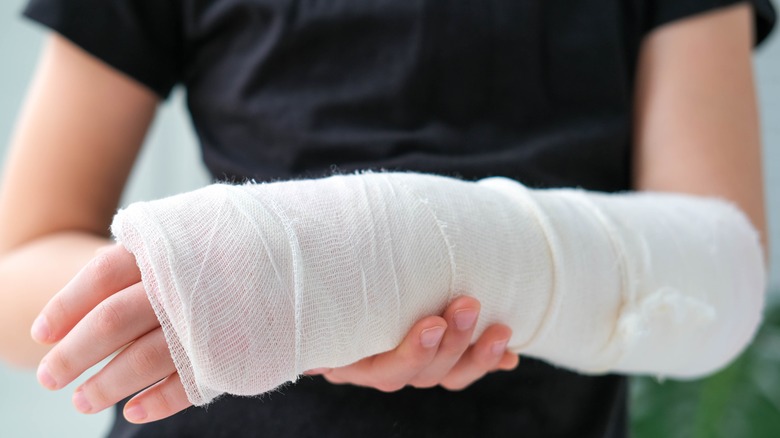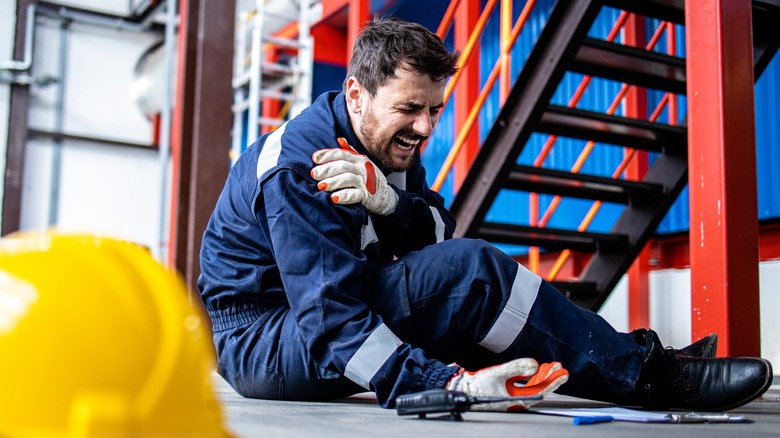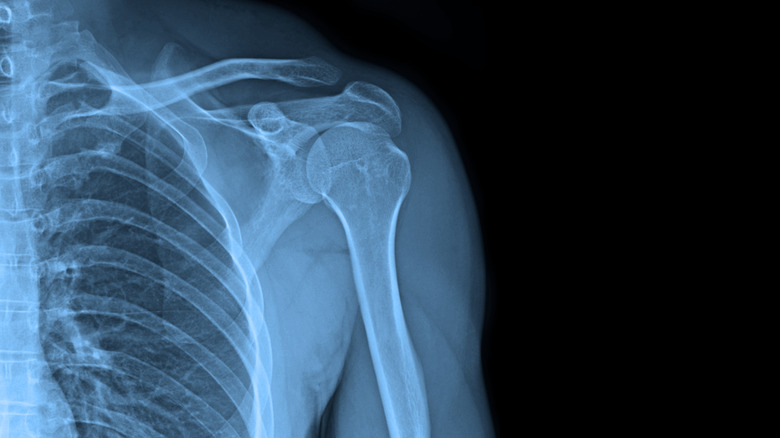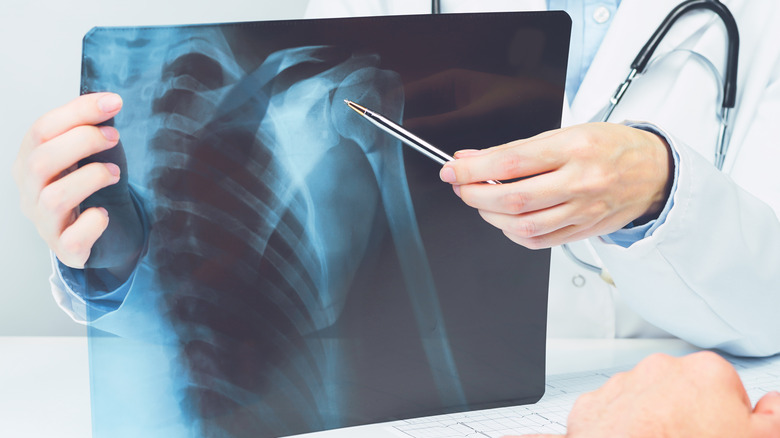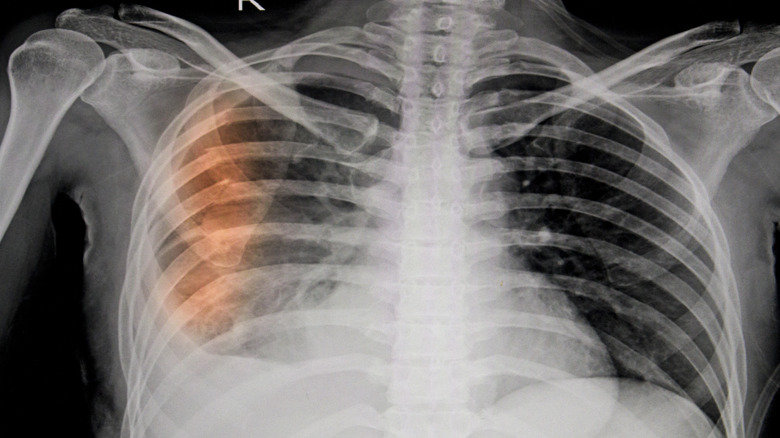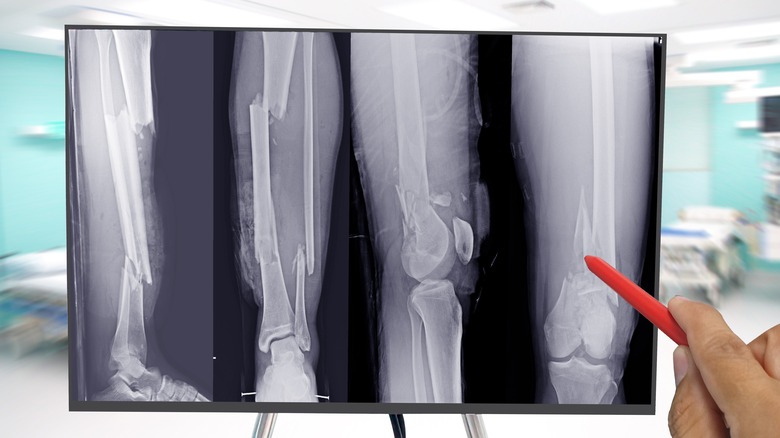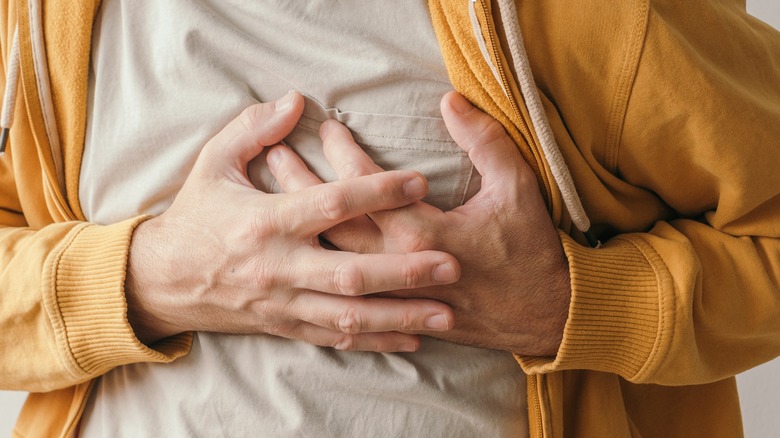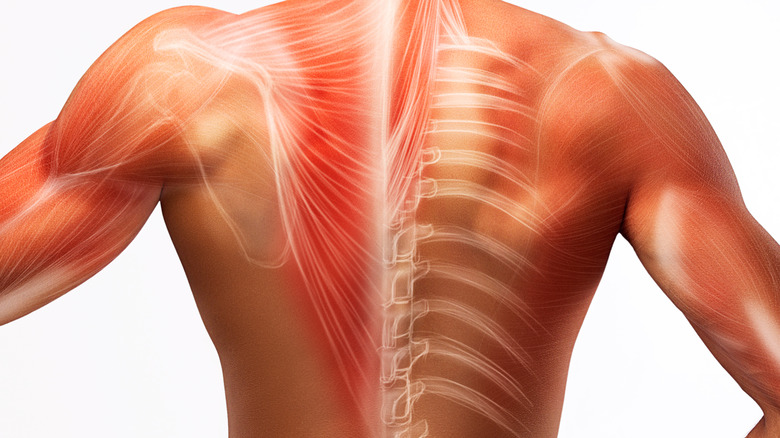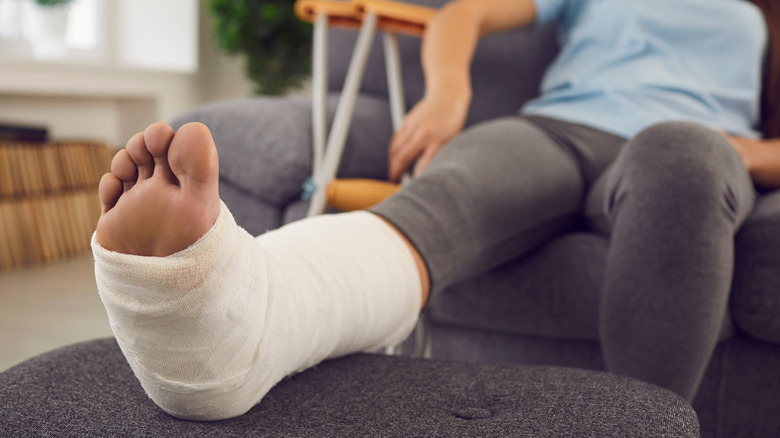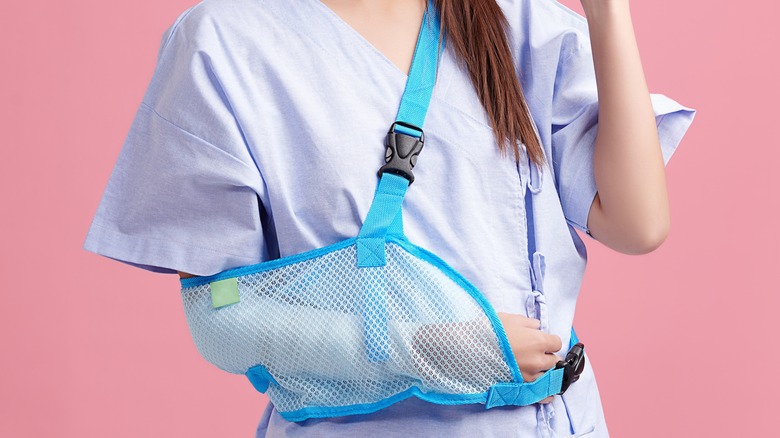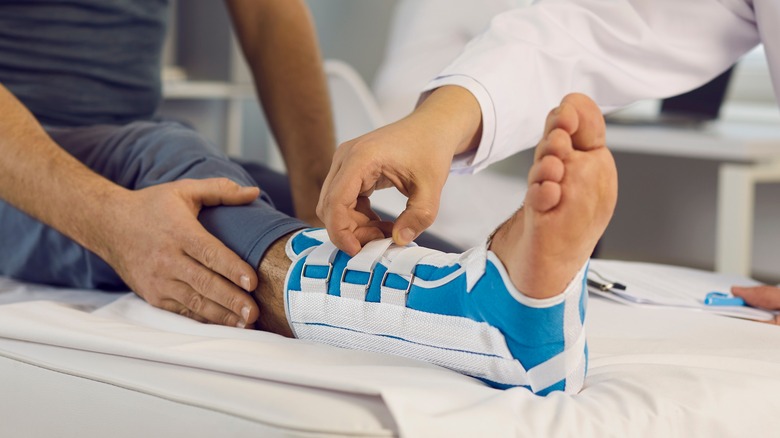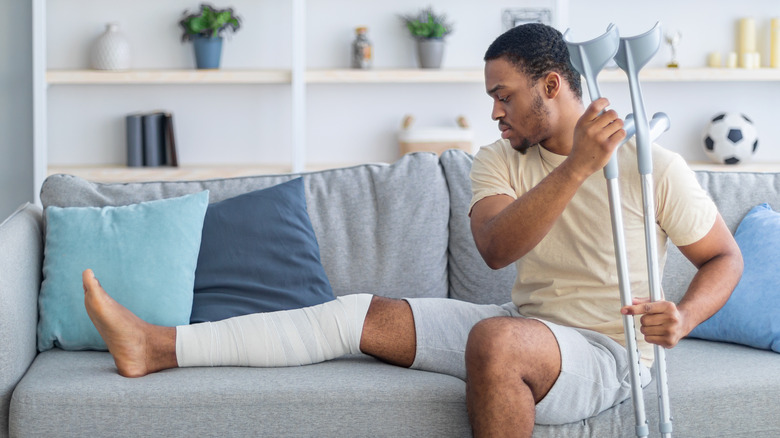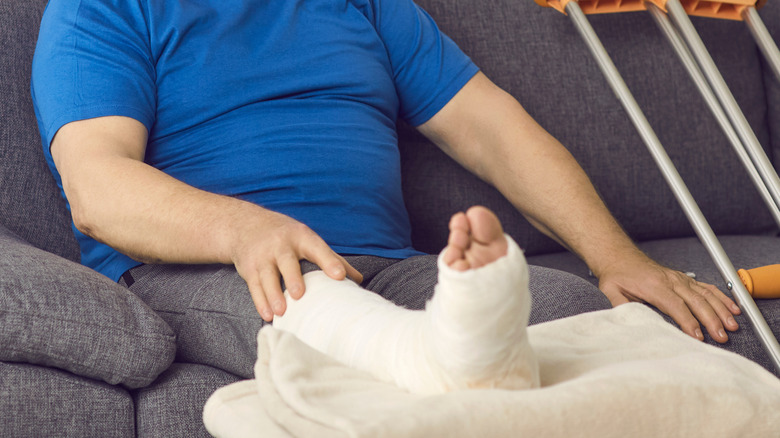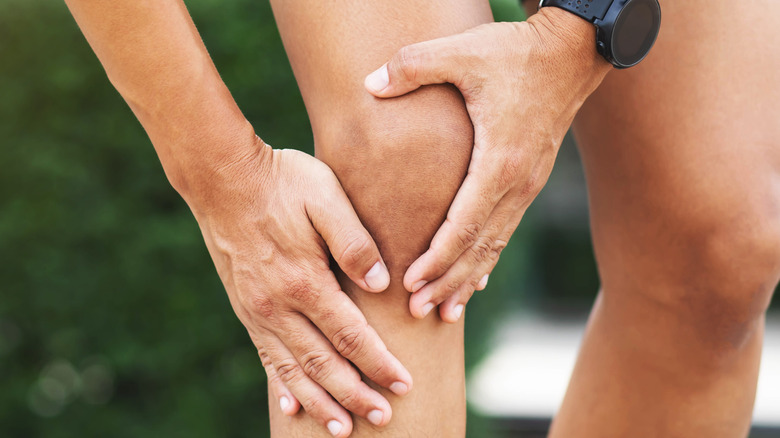What Happens To Your Body When You Break A Bone
Broken bones can be painful, and they might take a little while to heal. Plus, there's the inconvenience of being sidelined from some of your favorite activities, like sports or even just going for walks around your neighborhood. You also might have to struggle with normal parts of your day, such as going down the stairs (if you broke your leg) or opening the door while carrying something (if you broke your arm).
While you're dealing with all of this, your body is doing some pretty incredible stuff. There's a whole process of healing that you can't see taking place under your skin as your body repairs the break in your bone. And there are even a few scary risk factors that you could find yourself up against if you don't get the proper intervention and treatment that you need.
Here's an in-depth look at everything that happens inside your body when you break a bone.
Force or trauma causes damage to a bone
Before understanding what happens inside your body when you break a bone, it's important to understand exactly what causes a broken bone. Not all broken bones are going to happen or be experienced the same way. Generally speaking, a bone will be broken because of overwhelming force, presumably one that's accidental, according to the UK National Health Services. As an example, NHS cites that a person could break a bone because they fell or because they were struck by something.
If you experience this kind of force or trauma, there will likely be indicators that a bone has broken. The most obvious one is the sound of snapping or grinding, along with severe pain, particularly if you try to apply pressure to the injured area or bear weight on it.
However, it's important to note that while things like extreme pain are common when bones are broken, this can be deceptive. A very minor break might not be very painful at all, which puts you at risk of neglecting your injury and suffering greater risk in the long term.
Damage might take the form of a fracture, bruise, or sprain
You might be surprised to learn that there are all kinds of bone injuries. While broken bones are the ones you likely hear about most often (and are considered the most severe), there are other ways you could hurt your bones.
The Cleveland Clinic explains that the formal medical term for a bone break is a "fracture," and this is what most doctors will call it when they are diagnosing it and explaining a plan of treatment. If your doctor tells you that you fractured a bone or suffered a bone fracture, that means it's broken.
In some cases, you might simply bruise a bone instead of breaking it. Just as your skin bruises when it is hit with something, your bones can bruise the same way — and blood can well up inside the bone, just as it would underneath the surface of your skin when bruised. Bone bruises can be painful and will often require medical treatment, but they are not as serious an injury as a fracture.
Finally, there's a sprain. This can be painful and can sideline you from physical activity the same way a fractured bone can, but in the case of a sprain, you have actually torn or stretched a ligament instead of a bone. Sometimes, a sprain happens simultaneously with a fractured bone.
Bones fracture in different ways
Did you know that bones can break in different kinds of ways? Medical experts have names for each specific type of fracture that can happen to the bones in your body. Kid's Health by Nemours lists seven types of broken bones, and any of these types of fractured bones can be identified via X-ray. The first of these is what's known as a greenstick fracture, which is when your bone is broken on only one of its sides. Compare something like a greenstick fracture to a torus fracture, which is when the bone bends outward on one side but doesn't break on its other side. A torus fracture is also sometimes referred to as a buckle fracture.
In some cases, a broken bone will be fractured in more than two separate parts. These types of breaks are known as comminuted fracture. Similarly, there might be an injury where a bone compresses or collapses in on itself, and these types of breaks are known as compression fractures.
Doctors could also diagnose what's known as an avulsion fracture, which happens when a shard of bone is broken off by a pull from a tendon or ligament. You could also suffer a stress fracture, which is when a bone cracks instead of completely breaking. Finally, when a child breaks a bone that's in the process of growing, this is called a growth plate fracture.
You could suffer blood loss or damage to surrounding organs
Broken bones can hurt a lot, and they will often hinder your ability to move while they heal. But there's a bigger concern regarding broken bones, and this is one that happens immediately after the bone breaks.
Underneath the skin, there's a high risk of potential complications, as explained by the Better Health Channel. The most prominent of these complications is blood loss. Even if you think of bones as the hard, white framework of your body, don't forget that these are actually thriving parts of your body — and as such, they contain a lot of blood. When your bones break, all of that blood will flow right out of them. When it's an especially large or complicated fracture, that could mean you lose a lot of blood. And heavy blood loss is never a good thing!
A similar problem is the damage your broken bone could do to surrounding organs. If a sharp piece of bone comes into contact with an organ, that could be a medical emergency. As examples, Better Health Channel notes that a fractured skull could send bone fragments into contact with the brain, or a fractured rib could come into contact with your heart or lungs.
You could suffer compartment syndrome
Unfortunately, there's another very serious side effect of a broken bone, and this is one that happens when you suffer what's known as a compound fracture.
According to the Hospital for Special Surgery, a compound fracture is when the skin tears and a broken bone extends through the skin. While this might sound gruesome, the problem with a compound fracture is much greater than seeing a protruding broken bone. A compound fracture puts you at risk of what's known as compartment syndrome, when the broken bone injures the surrounding muscle tissue and that tissue begins to swell. Because muscle tissue is enclosed along with other types of tissue, including nerves, inside a sheath of tissue known as fascia, this becomes a problem. Fascia doesn't stretch to accommodate the swollen muscle, which puts pressure on the nerves and can damage them or even kill them.
Ultimately, the muscles or nerves could become nonfunctional because of compartment syndrome. That's why this reaction is considered a medical emergency and requires surgery to alleviate the pressure cause by the swollen muscle.
There could be an embolism
Another immediate risk of a broken bone is an embolism, either a pulmonary embolism (more common) or a fat embolism (less common), according to the Merck Manual. A pulmonary embolism is what will happen when you break your hip or pelvis. This will form a blood clot, which can then break off from where it has formed within a vein. Now broken off, this clot of blood is what's known as an embolus. It moves through your circulatory system toward the lungs, where it can get stuck in an artery and stop up your blood flow. Without blood flowing freely to or from your lungs, your body is quickly deprived of oxygen, which can result in death.
Slightly less common, though still possible, is a fat embolism. This happens when a type of fat inside your bones known as marrow leaks out from the fractured bone. This fat can then go through your circulatory system to your lungs, where it forms a pulmonary embolism that stops blood from flowing through your vessels and transporting oxygen.
If you are experiencing shortness of breath or any kind of chest pain, or if your skin has turned blue, this could be a sign that you are experiencing an embolism related to your fractured bone.
Your bones naturally try to heal almost immediately
When you break a bone, the area of your body where the fracture happened will likely start to swell very quickly. Peconic Bay Medical Center explains that this is a normal immune response.
Blood, bone marrow, and tissue are responding to the injury; almost immediately, your body's cells are trying to repair what was damaged and create new bone and cartilage. Think about a scrape or a cut that you get on your skin — while it may bleed initially, your blood will eventually clot so that you don't continue bleeding while the skin heels. This is the same thing that happens inside your body with your bones. The blood vessels inside your bones quickly clot and form a hematoma to fill in the space of your bone's fracture.
WebMD compares your body's immunity response to trash collection. Your immune system sends cells to the injured area that will remove bone fragments and protect your body from infection that may have resulted from exposure to germs.
After inflammation subsides, your body goes into the repair stage
You can expect the initial inflammation stage following a fracture to last for about two to three weeks, according to Patient. After this, all of the healing and repair work inside your body will start to take place, beginning with the formation of calluses, followed by the hardening of those calluses, and eventually the formation of remodeled bone (more details on each of these stages shortly).
However, the important thing to note throughout this healing process is the significance of adequate medical care and treatment. For example, the repair stage requires a lot of stability for the broken bone, which explains why casts or splints are often used to aid in the healing process. Additionally, a patient healing from a fractured bone needs good nutrition and plenty of blood in their system to heal this kind of injury. Somebody who is badly anemic or who does not have adequate intake of all the nutrients they need might not heal quickly or sufficiently.
Soft calluses form, followed by hard calluses
The clotting blood that forms around the ends of a broken bone don't just suddenly turn into full repaired bones — there's a full process happening inside your body during the weeks that healing takes place, and it begins with the formation of calluses.
According to KidsHealth by Nemours, calluses will usually form while the injury is still inflamed, sometimes as soon as a week of the fracture. The calluses are soft at first — much too soft to bear weight or to sufficiently provide the support that your skeletal system normally does. But even though these soft calluses aren't as strong as typical bone, they are enough to hold the fractured bone together. Once they have formed, they will begin to harden over the course of the next two to six weeks.
When the calluses harden, they strengthen, too — and they'll eventually be able to bear weight the same way that bone can.
Calcium deposits strengthen the calluses into remodeled bone
How is it that a soft callus is actually able to get hard? It's because of a mineral that you've likely heard before is very good for your bones: calcium!
Merck Manuals explains that calcium is what makes your bones strong. The freshly formed calluses that bond the broken bone together are so soft because they don't have the same calcium that give healthy bones their density. However, once the calluses have formed, your body begins depositing calcium into the calluses, which is what gradually causes them to become harder and stronger. The harder the calluses are, the more they are able to bear weight and the less likely it is that they will get pushed or pulled out of place, which would negatively affect your healing process.
Hard calluses fortified by calcium will show up on X-rays, so your doctor will be able to advise you when your healing process is far enough along that you can start to move normally on the injured part of your body.
Your bone could heal in a deformed way if not properly aligned
When your doctor puts a cast on the part of your body with the bone fracture, this is to ensure that the broken parts of your bone are lined up properly while you undergo the healing process. If you were not wearing a cast, or if the cast were applied improperly, then healing might not be quite so successful.
Sometimes bones can be improperly aligned, and then they heal in this improper alignment. At the end of the healing process, you would have a bone that is now in the wrong position. This is known as a malunion (per Henry Ford Health). Extra precautions can be taken to avoid malunion by holding the bone stable with both internal and external fixators. Some examples of these fixators that Henry Ford Health lists are bars or rods, as well as plates and screws.
Full recovery looks different for everyone
If only you could sit there and watch your bone as it heals under an X-ray, then you wouldn't have to constantly worry about what's happening under your skin as your bones heal themselves. But unfortunately, that's not the case. And while you might be curious about the specifics of your internal healing, the reality is that healing a broken bone isn't a one-size-fits-all experience.
Ortho Info explains that the shorter end of the expected healing timeline might be only several weeks. On the other hand, a more serious fracture could end up taking a few months to repair. Another factor affecting the duration of your healing process is how well you take care of yourself during the healing process and do what your doctor tells you to do. Pain might last for a little while, or it might go away quickly. And depending on what part of your body suffered the fracture, how long it takes to heal, and how strong you were beforehand, you might lose mass, strength, or flexibility in that part of your body while it heals.
You can improve the healing process
One thing that's particularly frustrating about not being able to see the healing process that's going on inside you under your skin is the persistent thought that there must be something you can do to speed up the healing process. "Why don't I have any control over this?" you might be thinking. And the truth is that you actually do have a little bit of control, according to Houston Methodist Leading Medicine.
Healthy choices during your recovery will mean your body is effectively set up to heal itself better. A nutritious diet with all the vitamins and minerals you need will provide your body with the right stuff for the biological processes it is undertaking. Most important among those nutrients are calcium and vitamin D. Some older patients might need to take supplements to get the amount of calcium and vitamin D they need to heal their bones.
Additionally, Houston Methodist recommends that patients quit cigarettes, because smoking changes the way your body's cells function, potentially stopping them from being able to create new bone mass.
You'll likely see no long-term effects
There's one upside to the long, tedious process of healing a broken bone: You likely won't have any lingering health problems after you're done.
Although there are some other injuries your body might suffer that could end up affecting your cognitive and physical abilities for a long time, broken bones aren't like that. According to the Better Health Channel, the most you might need to prepare yourself for is rehabilitation. After your cast comes off and you find yourself with a slightly weaker limb, you'll need to do specific exercises to regain your strength and mobility. However, this should be the extent of the after effects — nothing long term or more extreme than that. You won't even have to worry about scarring or any physical blemishes, because a damaged bone doesn't have scars the way damaged skin does.
With that said, while you are rehabilitating, your doctor might still want to do an X-ray on your healed bone, just to make sure everything looks the way it should.
How to be safer to avoid breaking a bone
Even though you have a body that is equipped to heal and recover from a fractured bone, leaving you healthy and capable once again when all is said and done, it's still best to avoid this injury altogether. And one of the best ways to do this is by making sure your bones are strong.
Mayo Clinic emphasizes calcium-rich foods like milk and yogurt, along with vitamin D-rich foods like fatty fish. Another way of improving bone strength is by undertaking weight-bearing exercise, which will give you the added benefit of good balance, thus reducing the risk of falls and accidents.
Finally, there are practical safety precautions you can take in everyday life, recommends Penn Medicine. Wearing protective gear for intense sports such as skiing and biking will protect your body parts from impact. You can also avoid any situations that put you at risk for accidental falls, such as standing on an unstable surface or trying to walk over an area with a slippery surface or that's covered with items you could trip over. By avoiding a broken bone in the first place, you don't have to put your body through the stress of healing it.

